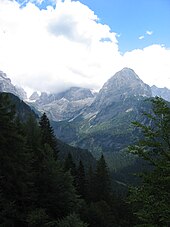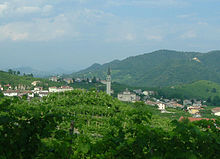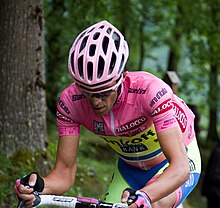2015 Giro d'Italia
The 3,481.8-kilometre (2,163.5 mi) race included 21 stages, beginning in San Lorenzo al Mare on 9 May and concluding in Milan on 31 May.
His defence of the pink jersey (given to the leader in the General classification in the Giro d'Italia) was put in doubt when he injured his left shoulder in a crash in the sixth stage.
Despite aggressive riding from Aru and Landa in the final week, Contador was able to defend his lead to the finish of the race.
Southeast's entry in the race was earned by their victory in the 2014 Coppa Italia, when they competed as Neri Sottoli; they were invited despite three recent doping cases in the team.
[4] CCC-Sprandi-Polkowice's invitation immediately received attention because the team's roster included two prominent riders who has previously served bans for doping: Stefan Schumacher and Davide Rebellin.
[7] George Bennett (LottoNL–Jumbo) was withdrawn from the startlist on the night before the race, however, as a blood test had revealed low cortisol levels.
The average age of riders in the Giro was 28.95; they ranged from the 21-year-old Rick Zabel (BMC Racing Team) to the 41-year-old Alessandro Petacchi (Southeast).
Although he finished first in the Giro, he only managed fifth place in the Tour; both results were subsequently removed because of a ban due to a doping case from 2010.
[11][12][15] Rigoberto Urán (Etixx–Quick-Step) – who had finished second in 2013 and 2014 – was also among the favourites, with the long individual time trial expected to suit him.
[16] Other riders expected to challenge for the higher places included Ilnur Zakarin (Team Katusha), who had just won the Tour de Romandie, Domenico Pozzovivo (AG2R La Mondiale), Jurgen Van den Broeck (Lotto–Soudal), Damiano Caruso (BMC) and Ryder Hesjedal (Cannondale–Garmin), the winner of the 2012 Giro d'Italia.
[11][12][13] Four former winners of the Giro started the 2015 edition: Contador, Hesjedal, Ivan Basso (Tinkoff–Saxo) and Damiano Cunego (Nippo–Vini Fantini).
The route would use the Riviera dei Fiori cycle path and would start at the foot of the Cipressa climb made famous by its inclusion in the Milan–San Remo classic.
Mauro Vegni, the race director, announced that the Giro would return to the climb of the Madonna di Campiglio for the first time since 1999.
[18] The full route announcement was made in Milan on 6 October at an event attended by many riders expected to participate in the Giro.
[20] The final week of the race began with a stage that crossed the very difficult Passo di Mortirolo on the way to a finish on a third-category climb in Aprica.
[27] This was followed by one of the flattest stages of the race, which took the Giro out of Italy for the first time in 2015 as it crossed into Switzerland for a finish in Lugano.
In general, the climbs were lower than in previous years, following controversy in the 2014 Giro over the crossing of the Stelvio Pass.
[35] There was particular concern during the stage after Domenico Pozzovivo (AG2R La Mondiale) crashed on a descent; he abandoned the race and was taken to hospital.
Contador was among the riders to crash; although he finished the stage on the same time as Greipel, he was treated for a shoulder injury by his team doctor and was unable to put on the leader's jersey on the podium.
The stage was won by Beñat Intxausti (Movistar), who was in the day's early breakaway and attacked on the final climb.
Astana again rode hard to put pressure on the other riders; eventually a group formed of Contador, Aru, Porte and Landa.
He therefore moved up into fifth place overall, while Contador increased his lead over Aru by winning bonus seconds at an intermediate sprint.
[42] After the rest day, stage 10 was once again won by a rider from a breakaway: Nicola Boem (Bardiani–CSF) sprinted to the victory from a small group.
Landa won the stage after Astana rode hard on the final climb; he finished five seconds ahead of Contador and moved back up to fourth place.
Contador had suffered a puncture at the foot of the penultimate climb – the Mortirolo – and at one point was nearly a minute behind Landa and Aru.
[51] Sacha Modolo won his second stage the following day, in a sprint finish, with Giacomo Nizzolo (Trek Factory Racing) moving into the lead of the points classification.
[55] At the foot of the final climb, Landa was ordered by his team to wait for Aru with the hope that, by working together, the two riders could put enough time into Contador to win the Giro.
The rider with the lowest cumulative time was awarded the pink jersey (the maglia rosa) and was considered the winner of the Giro d'Italia.
[69] A similar classification, the Azzuri d'Italia prize, was decided by points awarded to the top three riders on each stage.
[70] Another classification – the combativity prize (Italian: Premio Combattivita) – involved points awarded to the first riders at the stage finishes, at intermediate sprints and at the summits of categorised climbs.






